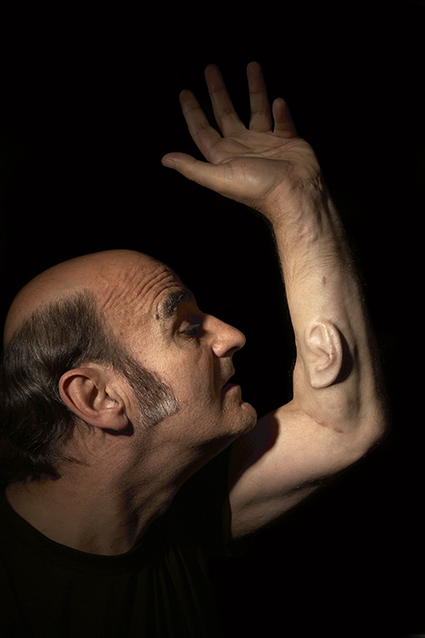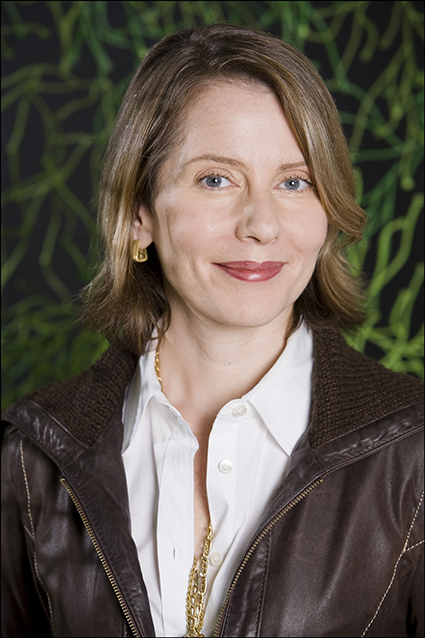 |
Stelarc Ear on Arm Portrait photo Nina Sellars, 2008 |
But this version assumes that whatever is being experimented with will always be applied and the result put on show and ‘tested’ on an audience. Instead of a laboratory where artists work away long-term at possibilities, uncertain of precisely where they’re going, this model comprises a production house with experiment-like development possibilities (staggered developmental stages, residencies, fellowships) but always with finite goals in mind. It’s the absence of open-endedness in some self-labelled experimental art that worries Oron Catts, Director of SymbioticA in the Centre of Excellence in Biological Arts, School of Anatomy and Human Biology, University of Western Australia. SymbioticA is host to the forthcoming second National Experimental Arts Forum.
Oron Catts, SymbioticA
Catts is concerned that “when a funding body gives a new title to a program [the Australia Council’s Emerging & Experimental] then everyone re-brands themselves to fit. So I’ll be interested to see who identify themselves as experimental artists so we can scrutinise what their practices are all about.” Of his own practice, based in the Life Sciences, Catts says, “The core is the experiment exploring the unknown, the question of the meaning of life. In my writing I contrast the mindsets of artists with those of engineers who usually set out to solve a specific problem and only address the issues immediately around the solution, which is not a very experimental process. The world is now led by engineering and managerial mindsets with no notion of any open-ended, curiosity-based questioning. You know the outcomes before you’ve started. Art is one of the last bastions which allows those explorations to take place.
“At SymbioticA we are problem-seekers rather than problem-solvers. We identify areas that require cultural scrutiny and which challenge our perceptions. I don’t believe that art should be in the service of anything except exploration.”
Since 2000, SymbioticA has been a leader in experimentation with in vitro meat production using tissue engineering. “As artists it’s about engaging very intimately with the other—food is a really great example because we have to incorporate it in our bodies—perhaps that’s an ‘invasive aesthetics.’ Our interest has been to raise questions about, say, how we treat other living beings. Now Google is investing millions of dollars into this area with a very false discourse about saving the world—it’s a ploy to raise funds from investors. [The project is led by computer scientist and Google co-founder Sergey Brin. Eds] We’re being exploited by becoming part of the in vitro meat narrative which was never our intention. What we do now is intervene by becoming part of the discourse around in vitro meat, being interviewed and posing subversive ideas, instead of using technology to conduct business as usual.”
For SymbioticA, the National Experimental Arts Forum (5-6 Oct) is part of a larger program, HR, which includes NEOLIFE SLSA (Society for Literature, Science and the Arts) 2015 (1-3 Oct), the first time an SLSA conference has been held outside the USA or Europe. It will address “scientists’ attempts to capture the public imagination” in respect of “forms of science on display and as a spectacle” as well as a host of legal, environmental and cultural matters.
 |
Paola Antonelli, 2008 photo Robin Holland |
"Many of the projects she likes and was involved in come from London’s Royal College of the Arts [where she is a Senior Fellow]. It has a program called Design Interruption with designers displaying speculative projects in progress. Catts also cites a speculative art proposal by TUur Van Balen and Revital Cohen: “soap-defecating pigeons, using synthetic biology to engineer the birds’ gut biome so they can produce soap in their faeces and move away from being pests to cleaning the urban environment. Obviously this was a very cheeky proposition, a way of making us address the issue that instead of changing our own behaviour with regard to the environment we come up with absurd interventions."
Catts thinks that “designers increasingly recognise that they are part of the problem rather than part of the solution and are moving into critical, fictional and speculative design. Those trained in this area are now starting to populate art galleries, starting with Paola at MoMA and then being embraced by more traditional art curators. It’s argued that the work communicates better than conceptual art and also that speculative design deals with very well executed models as opposed to artistic practices which are much more grounded in the reality of the materials used. I’m intimately involved in this debate.”
Catts pulls together the critical, fictional and speculative design labels into one—“contestable design,” which he associates with performance artist Stelarc and “the need to present prototypes of things which are not necessarily desirable,” as well as “a need to identify ontological holes which engineers and designers are digging for us without even recognising they are doing so...” Catts sees contestable design and experimental art doing battle with “one of the most dangerous challenges to engagement with new knowledge—TED talks, warm, fuzzy, easily digestible McKnowlege, always ending up with the positive, turning it into venture capital and unrealistic futures.”
The NEOLIFE conference’s thematic centrepiece will be the mouse with a human ‘ear’ grown without genetic engineering from cow cartilage cells on its side (University of Massachusetts Medical School, 1997). It will feature in DeMonstrable, an exhibition curated by Catts with Elizabeth Stephens and Jennifer Johung at the Lawrence Wilson Art Gallery (3 Oct-11Dec), featuring the science and the art and popular culture responses to the work.
Sunday 4 October, before the NEAF swings in to action, will be dedicated to Creative Research into New Genres—“or ‘CRINGE,’ quips Catts, “or, for George Brandis, New Genres of Excellence.” It will feature a performance by Stelarc, Guy Ben-Ary’s cellF Project, The Bio-Fiction Film Festival, Pony Express’s Eco Sex, Magnolia’s Up Late: Experimental Art Edition, new music from the UWA Faculty of Music and a National Day of Cringe soapbox session, “so that complaints about arts funding don’t invade NEAF forum sessions.” Day 1 of NEAF, says Catts, will feature keynote addresses by Stelarc, Cat Hope and the PVI collective—all Perth-based artists—panels and opportunities to whiteboard topics for Day 2 with its open discussion and breakout sessions. The venue is the Art Gallery of WA, with gallery-goers able to come across the forum. In the final session some of SymbioticA’s international guests will provide their perceptions of Australian experimental art.
David Sudmalis, Australia Council
David Sudmalis is Director of Emerging and Experimental Arts at the Australia Council which initiated and funds the NEAF. He’s also a practising composer. I asked if he sees himself as an experimental artist? “I do,” he replied, “but quite distinctly and separately from my job at the Australia Council, although there’s a body of knowledge that feeds in. Certainly my work in infrasonic sound, the sound below 20 Hz, and the involuntary physiological and psychological response to infrasonic stimuli sits at the core of my practice. I’ve been doing that for about 15 years now. It’s very much an experimental investigation and there is a body of scientific evidence undertaken internationally that can help inform it. There’s work I do in installations for gallery spaces or film soundtracks or video works that are sometimes experimental and sometimes not.”
I ask if Sudmalis thinks that science’s insistence on testing, verification and control groups can be introduced to art. He sees “a danger in being too fixed about a definition of what might constitute experimental art. For a long time, aspects of the arts and artistic practice have been linked with the sciences. If my memory serves me correctly, in the 16th century music was considered a branch of mathematics. What excites me about the breadth of practice in what we might call experimental arts is that it challenges as much the techne [making or doing, from the ancient Greek. Eds] as it does the concept and that for me is where the real challenge and vitality of the practice lies. There’s an unknown quality to the practice that is pure research in the true sense of the word. It is speculative and investigative and I think that doesn’t necessarily mean that there’s a tie to the sciences even though there sometimes and often is. What excites me a great deal is the tie-in with conceptual interrogation, the emergent issues of our time. I think that’s where great experimental practice tends to sit for the moment.”
I wonder how experimentalism fits with with production-oriented grant applications? Sudmalis says that “grant applications, strive for clarity of idea and purpose and a linear progression from concept through practice to resolution but that doesn’t necessarily lend itself particularly well to experimental practice. But what is really gratifying is that at the Australia Council there’s a commitment to peer assessment and peer review. There’s a group of eminently qualified people sitting around the table who understand the nuances and vagaries of experimental practice. So the discussions that are had with those who are professionally engaged in experimental practice tend to remediate that complexity.”
Sudmalis hopes that the National Experimental Arts Forum “will provide a profile—for government, the wider arts sector and the broader community—of the Australian vanguard of artistic practice.”
SymbioticA, National Experimental Arts Forum, Art Gallery of Western Australia, Perth, 5-6 Oct
RealTime issue #128 Aug-Sept 2015 pg. 16
© Keith Gallasch; for permission to reproduce apply to [email protected]








 back
back